Congratulations!
You've got a new succulent plant (or maybe a few of them). Now you are looking for a name.
You may already know that task is easier said than done. This site exists to ease your identification pain!
Since even the most common plants are often sold without names, new succulent owners are often left hunting for a name with
few places to turn. This page is designed to speed up ID on the succulents that are most common and that is why this
is the perfect place for you to start!
ATTENTION!! This page features only "non-cactus succulents",
if your plant is a cactus, visit the sister site: CactiGuide.com!
Here are the 10 most common succulent plants that come up for ID. If you cannot find your plant in the list below, then you can use
the other search features on this site. And last, but definitely not least, you can post an
ID request on the Cactus and Succulent Forum where one of our friendly members will
be sure to get a positive ID for you if anyone can.
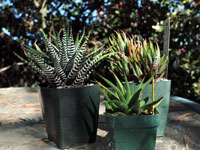
Haworthia attenuata |
1. Haworthia attenuata This species easy to grow, does not get very large, and has a striking appearance. These factors contribute to the
popularity of H. attenuata in cultivation. These can be found as individuals, but are also frequently sold in succulent "dish gardens". There are various
forms that vary some in appearance as illustrated. Haworthias are part of the Aloe family. For more on H. attenuata click here.
|
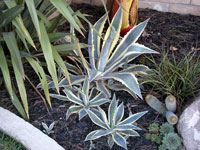
Agave americana |
2. Agave americana Specimens of this Agave are quite popular in warmer climates such as Southern California where they are planted as landscape plants. Here they easily
exceed 6 feet in height and diameter forming large rosettes with extremely sharp leaf-tips. The variegated form with white margins (stripes) is more popular, however, the normal blue-green
form is not at all hard to find. As with most Agave species, these almost always come up for ID when they bloom because of the dramatic speed and size of the bloom stalk. This blooming only
happens once and then the plant will die. This takes decades to happen in large Agave species and therefore the name "Century Plant" is applied although it rarely takes 100 years for
any given plant to bloom. Visit this page for more on A. americana. Several other Agave species come up often including Agave victoriae-reginae.
|
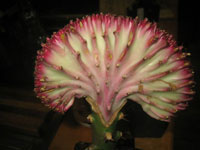
Euphorbia lactea (crests) |
3. Euphorbia lactea (crests) The striking color and bizarre growth of this mutated plant make it especially popular. In stores, these are almost always labeled "Fan Cactus"
despite the fact that it is not a cactus at all, but a Euphorbia. Not all plants are the variegated or whitish-colored forms and may be green, but in both cases, they are
sold as grafts. Two plants that have been cut and grown together as crested plants do not come through from seed and any without green lack chlorophyll and so cannot survive without a
green stock. The plant pictured on this page is perhaps the most common form of E. lactea sold. Other forms can be seen here.
|
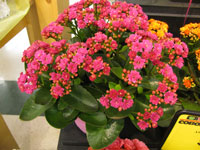
Kalanchoe blossfeldiana |
4. Kalanchoe blossfeldiana This plant has large dark green succulent leaves which make it an attractive plant, but the popularity is mostly due to
the variety of flowers and winter-blooming nature. Many cultivars or forms of this species exist and finding a 'true' species is not likely. These
cultivars may have orange, pink, red, white, or red flowers and some varieties have double flowers. More pictures here.
|
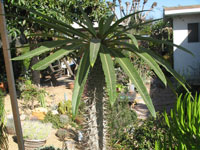
Pachypodium lamerei |
5. Pachypodium lamerei Known by the common name, "Madagascar Palm", P. lamerei is by far the most commonly encountered
Pachypodium species. While these
form 15 foot tall trees in habitat, they can be grown in pots successfully where the size is restricted by the limited root space. These odd plants have the overall
appearance of a little palm tree with a spiny trunk. However, the leaves are not fronds like a palm, but are deciduous single leaves. The leaves and flowers are
very similar to that of a Plumeria although they lack the strong fragrance of Plumerias. To learn more, see this page.
|
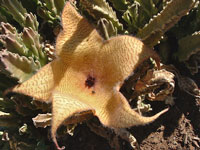
Stapelia gigantea |
6. Stapelia gigantea This stem succulent is widely cultivated and most people seek out an ID when their plant unexpectedly flowers. Often mistaken as a "cactus",
the stems of this species are four-angled and grow in a an upright cluster, sometimes drooping or sprawling. While there are some 50 or so species of
Stapelia, S. gigantea is the most popular primarily due to its extremely large flower which has been
reported to reach 19 inches (50cm) from tip to tip! All but two species in this genus have a flower odor that smells like a dead rotting animal. When unsuspecting
owners experience these large stinky flowers for the first time, their interest in the plant is instantly elevated and a name is sought. Details on S. gigantea can
be found here.
|
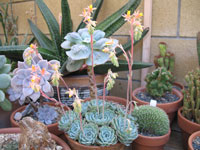
Echeveria species |
7. Echeveria species - There are over 150 species of the leafy-succulent genus, Echeveria. Most form
tight little "rosettes", but some are a more lengthy, sprawling habit. The overall appearance of Echeveria is quite similar to other genera in the
Crassula family, especially
Dudleya and Sempervivum. These can be
easily distinguished by their blooms. Echeveria are small succulents that grow readily and are
easy to propagate. Their small size makes them especially suitable to pots. Although "dish gardens" should be avoided, Echeveria species
are frequently included in these at stores.
|
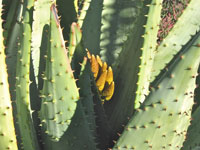
Aloe species |
8. Aloe species The Aloe genus is huge with over 400 species recognized. While
nearly everyone is familiar with the species Aloe vera, most know little about the other species. Aloe
species are found throughout the continent of Africa and surrounding islands. Species vary from small, soft, flexible leaves to geometric, compact rosettes to imposing, sturdy
trees. Some of the more popular Aloes in cultivation are: Aloe variegata,
A. ferox and A. marlothii.
|
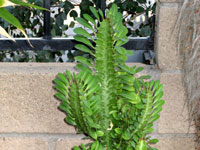
Tree-like Euphorbia |
9. Tree-like Euphorbia There are some species of Euphorbia that are almost unanimously confused with cactus to anyone who does not have at least a moderate
interest in succulent plant species. While there are smaller globose or columnar species that have a cactus-like appearance, none of those are as popular as the
tree-like or "candelabra" Euphorbia species. These closely resemble the cactus stereotype with fleshy-green stems that feature rows of sharp points (variously referred
to as spines or thorns) along with a habit of producing upright branches. The two most common of these tree-like Euphorbias are
E. ingens and E. trigona.
|
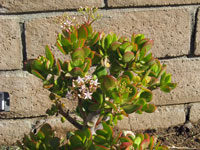
Crassula ovata |
10. Crassula ovata This is a popular indoor plant often called a "Jade Plant" or "Jade Tree". These plants are compact shrubs that
tolerate a fair amount of abuse which makes them popular house plants. While they prefer strong light and a well-draining soil mix and relatively infrequent watering,
they seem to grow quite well in lower light, a rich potting mix and excess moisture. These conditions can cause the plants to rot, however, most survive. They are
also very easy to propagate by simply rooting a cutting of the stem or leaves. The plants themselves are very "rubbery" feeling and quite flexible. The leaves
are fleshy green "medallions" which will have a red margin in strong light. See more.
|
| Some additional names that you can check first are: Kalanchoe daigremontiana, Euphorbia milii,
Adenium obesum, Gasteria pulchra,
Gasteria carinata var. verrucosa, Crassula falcata,
Crassula arborescens, Sedum rubrotinctum,
Sedum burrito, Aeonium
|
|